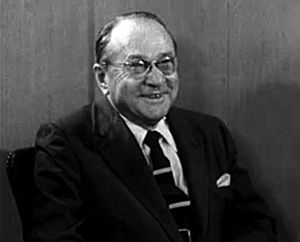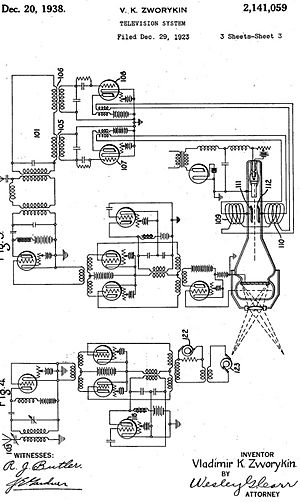Vladimir K. Zworykin facts for kids
Quick facts for kids
Vladimir K. Zworykin
|
|
|---|---|

Vladimir Zworykin, c. 1956
|
|
| Born |
Vladimir Kosmich Zworykin
1888 or 1889 Murom, Vladimir Governorate, Russian Empire
|
| Died | July 29, 1982 (aged 92–94) Princeton, New Jersey, U.S.
|
| Citizenship | Russian, American |
| Education | Saint Petersburg State Institute of Technology ESPCI University of Pittsburgh (PhD) |
| Spouse(s) | Tatiana Vasilieff (m. 1915) 2nd wife Katherine Polevitsky (m. 1951) |
| Engineering career | |
| Projects | Television, Electron Microscope |
| Significant design | Iconoscope, Photomultiplier |
| Significant advance | Inventor of the kinescope and other components of early television technology |
| Awards | IRE Medal of Honor, 1951, IEEE Edison Medal, 1952 |
Vladimir Kosma Zworykin (born in 1888 or 1889, died July 29, 1982) was a Russian-American inventor and engineer. He was a true pioneer in the world of television technology. Zworykin created a system for sending and receiving television signals using special tubes called cathode ray tubes. He played a huge part in making television a reality, developing important parts like tubes that could store electric charge, tubes for seeing in infrared, and even the electron microscope.
Contents
Early Life and Education
Vladimir Zworykin was born in Murom, Russia. His family was wealthy because his father was a successful merchant. Vladimir had a peaceful childhood. He didn't see his father often, except during religious holidays.
He went to the St. Petersburg Institute of Technology. There, he studied under a professor named Boris Rosing. Zworykin helped Rosing with his experiments on television. They worked in Rosing's private lab, trying to solve the problem of "electrical telescopy." This was a new idea for Zworykin, but Rosing had been secretly working on it since 1902.
Rosing had even filed a patent for a television system in 1907. His system used an early cathode ray tube to receive images and a mechanical device to send them. In 1911, Rosing showed an improved version of his TV system. This was the world's first public demonstration of television.
Zworykin's Career Journey
Zworykin finished his studies in 1912. After that, he went to Paris to study X-rays with Professor Paul Langevin. When World War I started, Zworykin joined the Russian Signal Corps. He worked testing radio equipment for the Russian Army.
In 1918, during the Russian Civil War, Zworykin left Russia for the United States. He traveled through Siberia and the Arctic Ocean before arriving in the U.S. He went back to Russia briefly but then decided to stay in the U.S. permanently.
Working at Westinghouse
Once in the U.S., Zworykin found a job at the Westinghouse laboratories in Pittsburgh. There, he finally got the chance to work on his television experiments.
In 1923, Zworykin applied for a patent for his television system in the U.S. He described his invention in two patent applications. He received a patent for one application in 1928 and two patents for the other in 1931. However, the equipment he described in these early patents was never successfully shown to work.
Around 1925 or 1926, Zworykin demonstrated his system to Westinghouse managers. It wasn't a big success, even though it showed the potential of using cathode ray tubes for TV. The management told him to focus on "more practical things." But Zworykin kept working on his system anyway.
In 1926, he earned his PhD from the University of Pittsburgh. His research focused on making photoelectric cells better. By 1929, he was experimenting with a new type of cathode ray receiving tube. He applied for a patent for this in November 1929. He called this new receiver the "kinescope."
Joining RCA and Developing the Iconoscope
In December 1929, Zworykin had a working model of his kinescope. He met David Sarnoff, who was a very important person at the Radio Corporation of America (RCA). Sarnoff hired Zworykin and put him in charge of developing television for RCA.
Zworykin moved to RCA's labs in Camden, New Jersey, in 1930. The big challenge was to create a good television transmitter. His team decided to develop a new kind of cathode ray transmitter. This idea was similar to one patented by Hungarian inventor Kálmán Tihanyi.
This new design was special because it could collect and store electrical charges between each scan by the electron beam. This was a completely new way for a TV camera tube to work. Zworykin's team started experimenting with this idea in April 1931. On October 23, 1931, they decided to call their new camera tube the iconoscope.
Zworykin first showed his iconoscope to RCA in 1932. He kept working on it. In 1934, he worked with RCA's partner, Telefunken, to create the "image iconoscope." By 1935, Germany's national postal service, the Reichspost, began public TV broadcasts using this improved tube.
Zworykin's work on television led to some disagreements with another inventor, Philo Farnsworth. Both inventors had ideas for TV. Eventually, RCA agreed to pay Farnsworth royalties for some of his inventions.
Later Life and Legacy
In 1951, Zworykin married for the second time to Katherine Polevitzky. She was a professor of bacteriology. Zworykin retired in 1954.
He became very interested in medical engineering and biological engineering. He helped start and became the first president of the International Federation for Medical and Biological Engineering. This group still gives out a "Zworykin Award" to honor great research in engineering.
Zworykin passed away on July 29, 1982, in Princeton, New Jersey.
Honors and Awards
Throughout his career, Zworykin received many important awards and honors:
- In 1934, he received the Morris Liebmann Memorial Prize.
- In 1941, he was chosen to be part of the American Academy of Arts and Sciences.
- He received the Howard N. Potts Medal in 1947.
- In 1948, he was elected to the American Philosophical Society.
- He was named honorary vice president of RCA in 1954.
- In 1966, he received the National Medal of Science for his work on scientific instruments, engineering, and television.
- In 1967, he received the Golden Plate Award from the American Academy of Achievement.
- He received the Faraday Medal from Great Britain in 1965.
- He was inducted into the U.S. National Hall of Fame in 1977.
- In 1980, he received the first Eduard Rhein Ring of Honor.
From 1952 to 1986, the IEEE gave awards in his name. Today, the Zworykin Award is given by the International Federation for Medical and Biological Engineering.
Remembering Zworykin
Zworykin has been honored in many ways for his amazing contributions. He was inducted into the New Jersey Inventor's Hall of Fame and the National Inventors Hall of Fame. A street on the Tektronix campus in Beaverton, Oregon, is named after him.
In 1995, a book called Zworykin, Pioneer of Television by Albert Abramson was published. In 2010, a documentary film about him, "Zvorykin-Muromets," was made by Leonid Parfyonov.
Zworykin is also listed in the Russian-American Chamber of Fame. This honor is for Russian immigrants who made big contributions to American science or culture.
See also
 In Spanish: Vladímir Zvorikin para niños
In Spanish: Vladímir Zvorikin para niños
- List of people known as "father" or "mother" of something
- John Logie Baird
- Kalman Tihanyi
|




